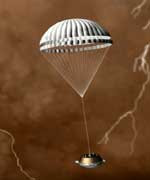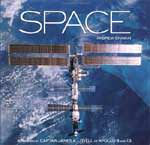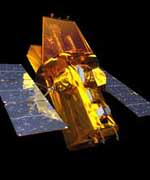All the scientific tools on NASA’s two Mars Exploration Rovers are still working well, a full 10 months after Spirit’s dramatic landing.
The ones on Spirit are adding fresh evidence about the history of layered bedrock in a hill the rover is climbing.
“Our leading hypothesis is that these rocks originated as volcanic ash that fell from the air or moved in ground-hugging ash flows, and that minerals in them were altered by water,” said Dr. Ray Arvidson of Washington University, St. Louis, deputy principal investigator for the mission.
“This is still a working hypothesis, not a firm conclusion, but all the instruments have contributed clues that fit,” he said. “However, it is important to point out that we have just begun to characterize the textures, mineralogy and chemistry of these layered rocks. Other hypotheses for their origin focus on the role of transport and deposition by water. In fact, it may turn out that volcanism, water and wind have produced the rocks that Spirit is examining. We are just beginning to put together the big picture.”
Both rovers completed three-month primary missions in April. NASA has extended their missions twice because they have remained productive longer than anticipated.
“We’re still making good progress even though Spirit has two types of problems with its wheels,” said Jim Erickson, rover project manager at NASA’s Jet Propulsion Laboratory, Pasadena, Calif. “We are working around those problems successfully, but they might be a sign of things to come, as mechanical parts wear out during our exploration of Mars.”
One question for continuing investigations as Spirit heads for rocks higher in the “Columbia Hills,” is what the environment was like when water altered the minerals. Possibilities include water in the volcanic magma mixture before the ash erupted, surface water transporting the ash while it was still loose after the eruption, and ground water soaking through the rocks that solidified from the accumulated ash.
Some clues for a volcanic-ash origin come from a layered rock dubbed “Uchben.” Researchers pointed Spirit’s microscopic imager at a spot on Uchben scoured with the rock abrasion tool. The images reveal sand-size particles, many of them sharply angular in shape and some quite rounded. The angularity is consistent with transport by an eruption. Particles carried across the surface by wind or water usually tumble together and become more rounded. Uchben’s rounded particles may be volcanic clumps, may be concretions similar to what Opportunity has found, or may be particles tumbled in a water environment.
Evidence for alteration by water comes mainly from identification of minerals and elements in the rocks by the rover’s Moessbauer spectrometer and alpha particle X-ray spectrometer.
The rovers’ principal investigator, Dr. Steve Squyres of Cornell University, Ithaca, N.Y., said, “We have really made headway just in the last several weeks in understanding these rocks. The most likely origin is debris that blasted out of a volcano, was transported by air or water to its present location, and settled out in layers.”
Opportunity, meanwhile, examined a lumpy boulder called “Wopmay” inside “Endurance Crater.” The slope of the ground and loose surface material around the rock prevented Opportunity from getting firm enough footing to use its rock abrasion tool. Evidence from the spectrometers and microscopic imager is consistent with scientists’ earlier hypothesis that rocks near the bottom of the crater were affected by water both before and after the crater formed. The evidence is still not conclusive, Squyres said.
Opportunity is heading toward the base of “Burns Cliff,” a tall exposure of layered rock in the wall of the crater. However, if the rover encounters more of the poor traction found around Wopmay, planners may change course and drive up out of the crater.
JPL, a division of the California Institute of Technology in Pasadena, manages the Mars Exploration Rover project for NASA’s Science Mission Directorate, Washington. Images and additional information about the project are available from JPL at http://marsrovers.jpl.nasa.gov and from Cornell University at http://athena.cornell.edu.
Original Source: NASA/JPL News Release



